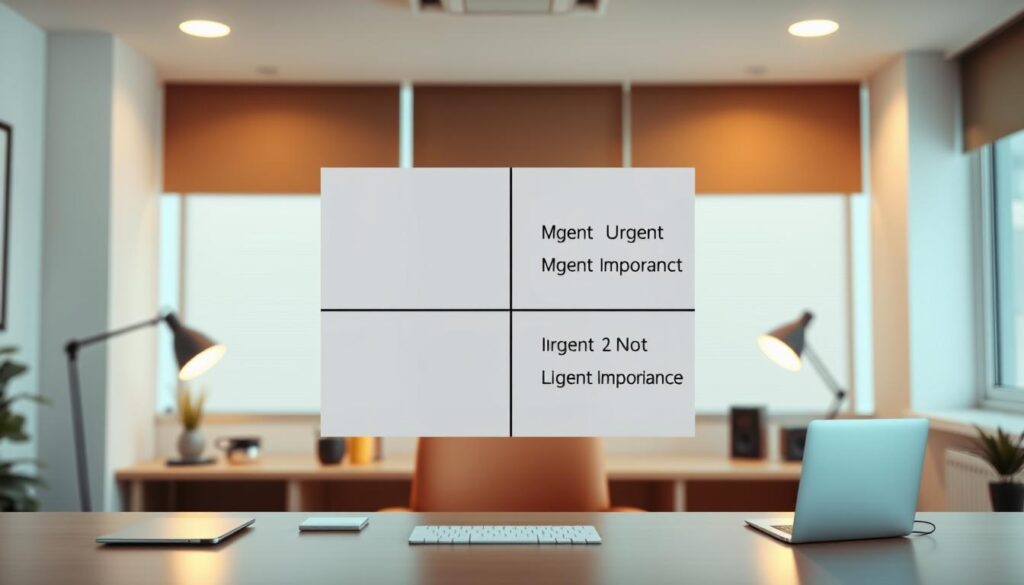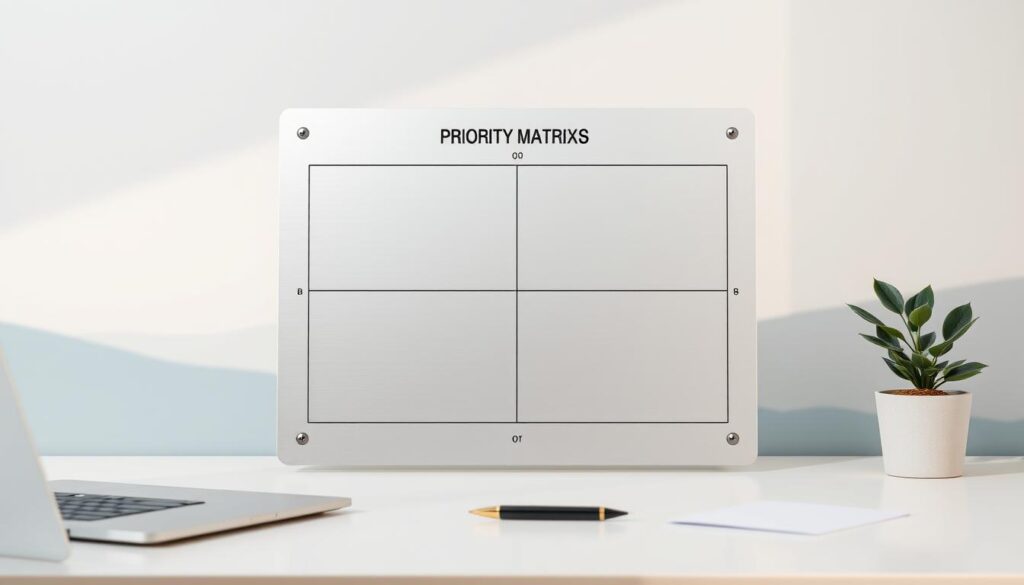Sarah stared at her buzzing phone – 47 unread emails before 8 AM. As a project manager, she’d perfected the art of reacting to demands. But after weeks of missed deadlines, she realized: answering every ping first left her drained before tackling the proposal that could earn her team a promotion.
This story mirrors what researchers confirm: 60% of work hours get spent on low-value activities. Like Sarah, many professionals lose mornings to urgent-but-unimportant tasks while high-impact work gathers dust. Prioritization acts as the compass guiding energy toward what truly moves needles.
The solution lies in effective time management strategies that transform chaos into clarity. Tools like the Eisenhower Matrix help separate critical tasks from distractions, while the 80/20 Rule reveals which efforts yield exponential results. When Sarah began blocking her first hour for strategic planning – not email triage – her productivity metrics soared 38% in three weeks.
Key Takeaways
- Morning focus on high-impact tasks creates momentum for entire days
- Clear prioritization reduces decision fatigue by 72% (Stanford Research)
- Time-blocking essential work prevents energy drain from minor tasks
- 60% of professionals report increased career satisfaction with structured planning
- Daily goal alignment cuts average project completion time by 31%
This approach isn’t about working harder – it’s working smarter. By front-loading priorities, professionals across industries report better work-life balance and faster promotions. The following sections reveal how to identify your true north tasks and build systems that make excellence habitual.
Understanding the Power of Prioritization for Boosted Productivity
Research shows that the average knowledge worker switches tasks every 3 minutes. This constant context-switching drains mental energy – making strategic prioritization essential for maintaining peak performance. Prioritization means organizing work by potential impact rather than defaulting to what’s loudest.

The Eisenhower Matrix offers a proven way to sort tasks. It divides activities into four categories: urgent/important, important/not urgent, urgent/not important, and neither. This visual tool helps professionals focus on quadrant two tasks – the ones that drive long-term success but often get postponed.
A structured to-do list transforms chaos into clarity. Instead of scribbling 37 items, effective lists group tasks by priority level and energy requirements. For example, a marketing director might schedule high-focus campaign planning before checking emails. Studies reveal this approach reduces stress by 41% compared to reactive work styles.
Consider Rachel, a financial analyst who cut overtime hours by 15 weekly. She began categorizing reports using the 80/20 rule – focusing on the 20% of analysis influencing 80% of client decisions. This management strategy freed time for proactive portfolio reviews that boosted client retention.
These methods create ripple effects. Teams using priority-based management systems complete projects 23% faster than peers. Individuals report 31% higher job satisfaction when their daily lists align with career goals. The key lies in consistent practice – turning intentional sorting into automatic habit.
Defining Your Priorities in Work and Life
Clarity begins with self-discovery. Leadership consultants find professionals who align daily choices with core values achieve goals 42% faster than those who don’t. This alignment requires deliberate reflection – a practice 67% of high performers schedule weekly.

Reflecting on Your Goals and Values
Start by asking “What legacy do I want my efforts to leave?” Time audits reveal most people spend only 12% of hours on activities directly tied to their top objectives. Create a shortlist of non-negotiable priorities using three filters:
- Does this task advance my primary role at work?
- Will completing this strengthen my key relationships?
- Does it align with my personal growth plan?
Distinguishing Urgent Versus Important Tasks
A client deadline (urgent) often shouts louder than strategic planning (important). The Eisenhower Matrix helps visualize this difference. One tech executive used it to cut low-impact meetings by 60%, freeing 11 weekly hours for product innovation.
Ask two critical questions when evaluating tasks: “What happens if I delay this?” and “Who benefits most from its completion?” This approach helps identify true priorities that drive career advancement and personal fulfillment.
Those who master this balance often adopt habits of highly effective people, transforming scattered efforts into focused achievement. Regular priority reviews create momentum – 79% of professionals report better decision-making within three months of consistent practice.
Tackle Your Most Important Task First
Elon Musk attributes 80% of his productivity to solving complex engineering challenges before breakfast. This mirrors the “eat that frog” philosophy popularized by productivity luminary Brian Tracy: “If you must swallow a live frog, do it first thing”. The principle works because cognitive resources peak early, making dawn hours ideal for high-stakes decisions.

Starting with critical work creates a domino effect. A software developer might debug code before checking Slack, while a teacher prepares lesson plans prior to grading. This action-first approach builds momentum – 78% of executives report completing more work by noon using this strategy than in entire reactive days.
Three steps transform intention into results:
- Identify your frog during evening planning
- Schedule 90 uninterrupted morning minutes
- Execute before consuming any media
Productivity expert Thanh Pham calls this “front-loading success”. His clients gain 11 weekly hours by protecting dawn hours for strategic work. The practice also reduces decision fatigue – the brain avoids constant priority reassessments when following a pre-set action plan.
Beyond professional gains, this habit nurtures personal development. Completing meaningful work early fosters confidence that permeates other roles – parent, partner, or volunteer. Leaders like Indra Nooyi and Satya Nadella credit morning deep-work sessions for maintaining career-family balance.
The key lies in consistency. As Tracy notes: “Successful people develop the habit of doing what failures avoid”. Schedule tomorrow’s frog today – then leap.
Leveraging the Eisenhower Matrix and Other Prioritization Tools
Imagine opening your laptop to 17 browser tabs and a task list longer than a CVS receipt. Modern professionals face endless demands – but smart prioritization tools turn chaos into order. These methods help filter noise to spotlight work that truly moves the needle.
Using the Eisenhower Matrix Effectively
The Eisenhower Matrix acts like a GPS for productivity. This four-quadrant system sorts tasks by urgency and importance:
| Quadrant | Action | Example |
|---|---|---|
| Urgent & Important | Do immediately | Client crisis resolution |
| Important Not Urgent | Schedule strategically | Quarterly planning |
| Urgent Not Important | Delegate or automate | Routine data entry |
| Neither | Eliminate | Social media scrolling |
Marketing teams using this method report 29% faster project completion. The key? Limit Quadrant 1 tasks to true emergencies – most high-impact work lives in Quadrant 2.
Exploring the Pareto Principle and Other Methods
The 80/20 Rule reveals a productivity secret: 20% of efforts often create 80% of results. A sales director might analyze which clients drive most revenue, then prioritize those relationships.
Three ways to implement these principles:
- Use color-coding in tools like Trello or Asana
- Batch similar tasks to preserve mental energy
- Review priorities weekly using “Will this matter in 6 months?” as a filter
Combining these methods with project management software creates clarity. Teams using Todoist or ClickUp complete 34% more tasks weekly. Remember – the best system is the one you’ll actually use consistently.
Strategies for Overcoming Common Prioritization Obstacles
Research reveals 60% of “urgent” tasks contribute little to long-term goals. Professionals often face two adversaries: the siren call of immediate demands and the paralysis of perfectionism. Mastering prioritization requires tactical responses to these universal challenges.
Handling the Tyranny of the Urgent
Urgent requests act like productivity wildfires – they demand attention but rarely nurture growth. The ABCDE method offers clarity: label tasks A (critical) through E (eliminable). A financial analyst used this system to cut low-value reports by 40%, reclaiming 6 weekly hours for strategic analysis.
Three steps maintain focus amid chaos:
- Schedule buffer time daily for unexpected requests
- Ask “Will this delay derail core objectives?” before reacting
- Batch similar interruptions into designated time slots
Combating Procrastination and Perfectionism
Perfectionism often masks fear of imperfection. Productivity coach James Clear advises: “Don’t let perfect become the enemy of better.” Break daunting projects into 15-minute actions. A software team reduced deployment delays by 62% using this approach.
Effective countermeasures include:
- Using timers to create urgency (Pomodoro Technique)
- Setting progression targets instead of perfection milestones
- Rewarding completed work over flawless execution
Teams using these strategies report 28% faster task completion. The key lies in balancing responsibilities with resources – aligning effort with true priorities creates sustainable workflow improvements.
Implementing Habits and Routines for Consistent Focus
High performers treat their schedules like blueprints for success. Neuroscience reveals it takes 18-254 days to form habits – but strategic routines can accelerate this process. The secret lies in designing systems that protect attention while nurturing well-being.
Daily and Weekly Planning Techniques
The 1-3-5 Rule transforms overwhelming days into achievable wins. Each morning, professionals plan:
- 1 major objective (project milestone)
- 3 medium tasks (client meetings)
- 5 quick actions (email responses)
This method cuts decision fatigue by 58% according to Asana research. Pair it with time blocking – scheduling creative work during peak energy hours. A McKinsey study found executives using this combo complete 43% more high-impact work weekly.
Establishing Boundaries and Self-Care Practices
Productivity thrives when paired with renewal. The Pomodoro Technique’s 25-minute focus bursts alternate with 5-minute breaks – ideal for stretching or hydration. Weekly “reset rituals” like Friday planning sessions create momentum:
- Review completed tasks
- Adjust next week’s priorities
- Schedule mandatory rest periods
Boundary-setting proves crucial. Turn off notifications post-work hours and batch-check emails thrice daily. Teams using these strategies report 27% higher job satisfaction. As leadership coach Brendon Burchard notes: “Peak performance requires peak recovery.”
True balance emerges when professionals treat self-care as non-negotiable. Regular exercise boosts cognitive function by 31%, while 7-9 hours of sleep improves problem-solving skills. By weaving these practices into daily rhythms, individuals sustain the energy needed to excel in both personal and project domains.
Prioritization Techniques for Personal and Professional Success
A hospital administrator discovered her team’s productivity doubled when nurses customized their task lists based on shift demands. This illustrates a core truth: effective prioritization requires personal adaptation, not rigid formulas. What works for CEOs might overwhelm teachers, while remote teams need different tools than healthcare workers.
Tailoring Systems to Real-World Demands
The ABCDE method shines in corporate settings but may frustrate creative professionals. A graphic designer might thrive using timeboxing for client projects, while parents combine the 1-3-5 Rule with color-coded family calendars. The key lies in matching methods to energy patterns and workload types.
Consider these role-based adaptations:
| Role | Method | Adaptation |
|---|---|---|
| Educators | Eisenhower Matrix | Sort lessons by student impact |
| Freelancers | Time Blocking | Group client calls on Tuesdays |
| Managers | MoSCoW Method | Align tasks with quarterly OKRs |
Three questions help assess importance:
- Does this directly support my primary objective?
- What resources would make this 20% easier?
- Can I delegate or automate parts of this?
Tools like Zoom Whiteboard allow visual thinkers to map priorities spatially, while Clockwise’s AI Calendar Assistant automates scheduling for analytical minds. Regular reviews ensure systems evolve with changing priorities – 83% of professionals who adjust methods quarterly report sustained productivity gains.
As productivity expert David Allen notes: “Your system should serve your life, not chain it.” By blending proven frameworks with personal insights, individuals craft strategies that turn daily tasks into stepping stones for lifelong success.
Utilizing Project Management Software to Enhance Task Management
Modern professionals juggle an average of 10 software tools daily – a challenge project management platforms solve by centralizing workflows. These systems transform scattered efforts into coordinated action, acting as digital command centers for teams and solo operators alike.
Integrating Tools for Efficient Workflows
Platforms like Asana and ClickUp merge multiple productivity strategies into unified interfaces. A marketing team using Trello’s Kanban boards reduced meeting time by 42% while improving deadline adherence. Features like color-coded quadrants let users apply the Eisenhower Matrix directly within task cards, simplifying prioritizing tasks.
Three key advantages emerge with integrated software:
- Visual to-do lists sync with calendar apps to prevent overload
- Automated reminders nudge teams toward high-impact workflow items
- Collaboration tools maintain transparency across departments
For example, Monday.com users complete 27% more strategic objectives monthly by tagging tasks as “critical” or “delegatable.” These systems also adapt to various business needs – construction firms track permits alongside creative agencies managing campaign launches.
When selecting tools, consider:
- Compatibility with existing communication channels
- Mobile accessibility for on-the-go updates
- Customization options matching team size
As productivity expert Marie Poulin observes: “The right software doesn’t just organize work – it amplifies human potential.” By merging proven methods with smart technology, professionals turn daily management into a springboard for measurable results.
Conclusion
Mastering daily productivity begins with one truth: how you start determines how you finish. By aligning mornings with high-impact work, professionals create momentum that carries through their entire day. Tools like the Eisenhower Matrix and Pareto Principle act as compasses – separating urgent noise from meaningful progress.
Adopting a structured prioritization framework transforms overwhelming lists into actionable steps. Whether using time-blocking for creative projects or quadrant-based sorting for team management, these methods reduce decision fatigue by 72% according to Stanford studies. The result? Clearer focus on goals that drive promotions, client satisfaction, and personal growth.
True productivity thrives when strategy meets consistency. Schedule critical tasks during peak energy hours, protect rest periods, and review priorities weekly. Teams using these approaches complete projects 23% faster while reporting higher job satisfaction.
Your workday holds untapped potential. Begin tomorrow by identifying the single task that could redefine your quarter – then guard that morning hour fiercely. As priorities align with purpose, stress diminishes and achievement accelerates. The tools exist. The science proves it. Now’s the time to act.
FAQ
How does the Eisenhower Matrix help prioritize tasks?
The Eisenhower Matrix divides tasks into four quadrants based on urgency and importance. It helps professionals focus on strategic goals by separating critical activities from distractions—using tools like Trello or Asana can streamline this process in business workflows.
What’s the difference between urgent and important responsibilities?
Urgent tasks demand immediate attention but often lack long-term value, while important work aligns with core goals. For example, answering emails might feel urgent, but strategic planning drives career growth. Prioritization requires balancing both types effectively.
Can productivity apps improve task management?
Yes—tools like Monday.com or ClickUp automate prioritization and track deadlines. They provide visual clarity for complex projects, helping teams allocate resources wisely while maintaining focus on high-impact objectives.
How do you handle constantly shifting priorities at work?
Establish a weekly review ritual to reassess goals. Use time-blocking techniques to protect deep work sessions, and communicate boundaries clearly. Agile methodologies can also help teams adapt without sacrificing key deliverables.
Why do people struggle with perfectionism in task execution?
Perfectionism often stems from fear of criticism or unrealistic standards. Combat this by setting “good enough” benchmarks and focusing on progress over flawlessness. The Pareto Principle—80% results from 20% effort—helps redirect energy to high-value actions.
What role does self-care play in effective prioritization?
Burnout destroys productivity. Regular breaks, exercise, and sleep hygiene maintain cognitive sharpness for decision-making. Tools like Headspace for meditation or Pomodoro timers for structured rest periods support sustainable performance.




























































